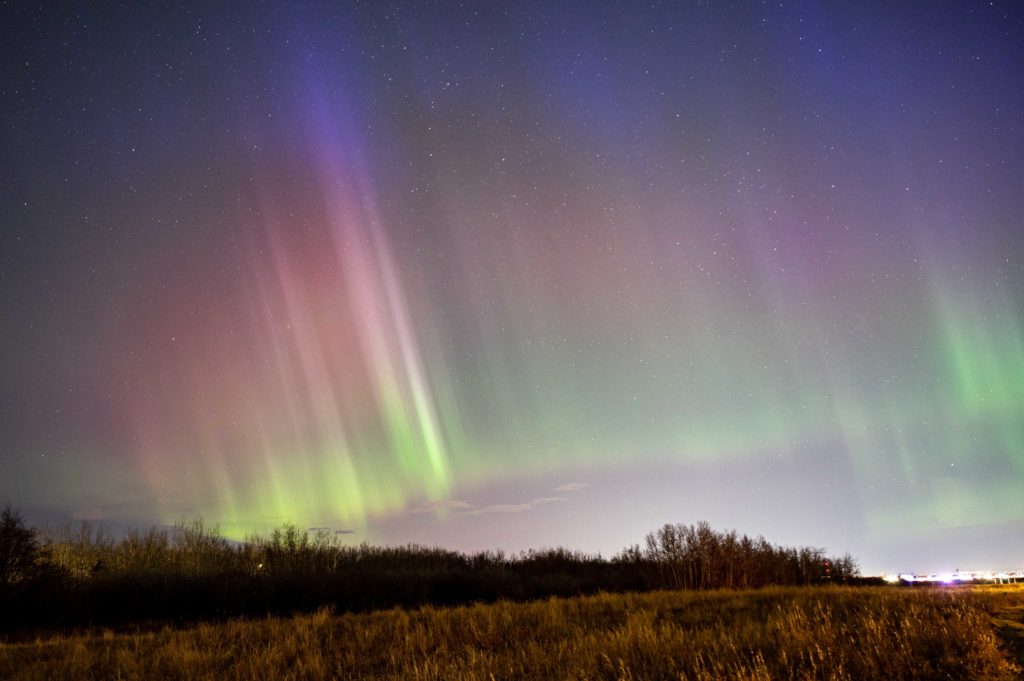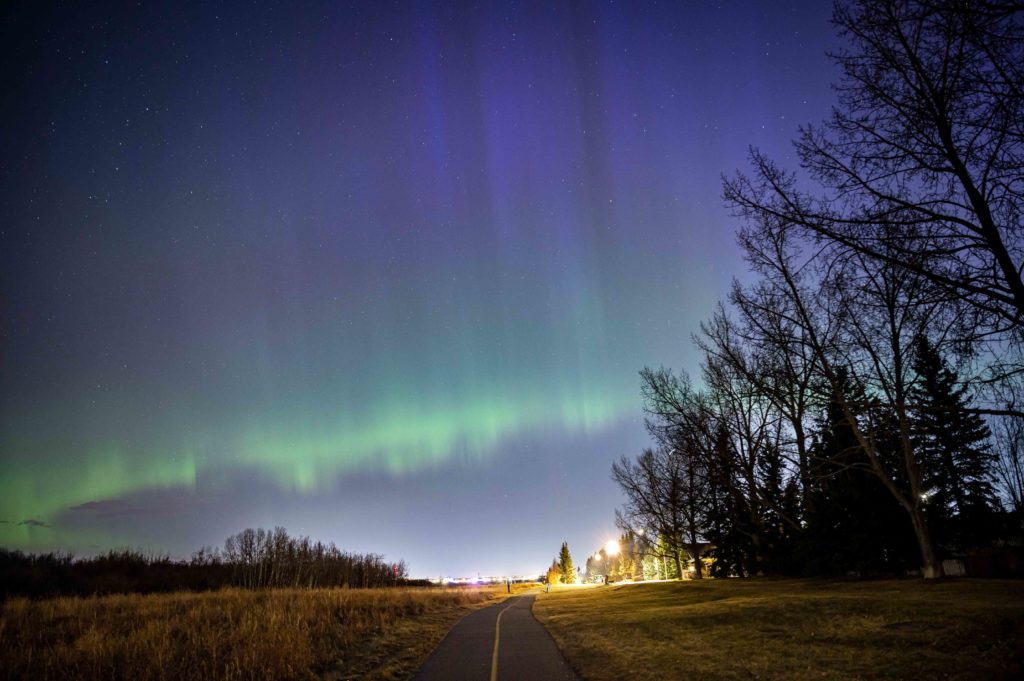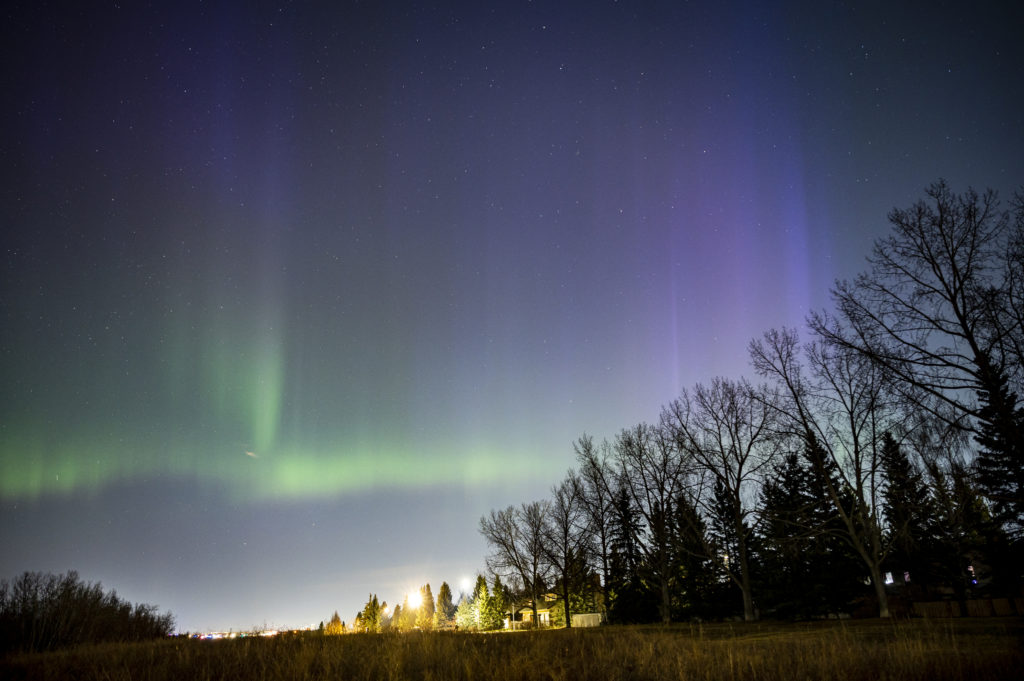
The sunrise comes late this time of year, especially for those who like me wake at 5 a.m. But on November 4, the man on the morning radio show announced, along with the standard traffic and weather reports, that a brilliant display of aurora borealis was underway and was visible from nearly anywhere in the city. So, despite a temperature well below freezing, I grabbed camera and tripod to head behind the house to see what all the fuss was about
There was plenty to fuss about, it turned out. In fact, it was the most spectacular auroral display this far south (about 51oN latitude) for the past decade and one of the best I’ve seen in nearly three decades. I managed to snap a few shots before dawn. And I hope, with a little luck, we all can see more auroral activity as the Sun moves towards its cyclical maximum of activity over the next few years.
An Ancient Pastime
Many skywatchers have never seen an auroral display, but aurorae have been witnessed since antiquity. The first written record of aurorae goes back to China more than 4,600 years ago in a passage that notes “Fu-Pao, the mother of the Yellow Empire Xuan-Yuan, saw strong lightning moving around the star Su, which belongs to the constellation of Bei-Dou (the Northern Dipper), and the light illuminated the whole area.” Much later, Babylonian skywatchers during the reign of King Nebuchadnezzar II around 568 B.C. noted their observations of a red glow in the northern sky even at their relatively southerly latitudes.
After witnessing an impressive auroral display on September 12, 1621, astronomers Galileo Galilei and Pierre Gassendi independently coined the name aurora borealis after Aurora, the Roman goddess of dawn and the Greek word boreas which means ‘wind of the north’. The southern hemisphere equivalent is called aurorae australis. Together they have the more ecumenical name of aurorae polaris.
The cause and origins of aurorae took some time to figure out. Galileo mistakenly thought aurorae were caused by sunlight reflecting from the atmosphere. This was off the mark, but he was correct about the atmospheric nature of aurorae rather than something that happened in deep space. In 1790, Henry Cavendish, the incandescently brilliant English physicist, used the trigonometric technique of triangulation to show most aurorae lay just 100km to 150km above the Earth’s surface.

How Aurorae Happen
In 1902 the Norwegian physicist Kristian Birkeland, determined, correctly, that auroral light was caused by currents flowing through the gas of the upper atmosphere, much like a neon or fluorescent light. Energetic electrons travelling at high speed transfer energy to the electrons of oxygen and nitrogen atoms which release this energy at discrete wavelengths governed by their atomic structure. Oxygen atoms about 100-150 km up tend to emit green light, while nitrogen emits blue, pink, and violet light. At an altitude of about 250 km, more rarified oxygen gas can emit deeper red light.
The electrons that tickle the gas in the upper atmosphere come from material ejected from the Sun. Solar coronal mass ejections (CME) blast immense amounts of charged particles into space at high speeds – though not at the speed of light. If a CME blasts out charged particles in the direction of Earth, auroral displays usually show up two or three days later.
The solar electrons are captured by the Earth’s magnetic field and impinge on the upper atmosphere, mostly in rings around the north and south magnetic poles. That’s why aurorae are most common in more extreme northerly and southerly latitudes. Regions such as Norway, Iceland, much of northern Canada, Alaska, and the coasts of Antarctica lie directly below these auroral rings and offer the best places to reliably see aurorae. Occasionally, after a particularly large ejection by the Sun, electrical activity wanders southward and aurorae become visible in New Zealand, southern South America, and California, for example. After historically violent CME outbursts in 1859 and 1989, aurorae were visible as far south as Cuba! In the November 4 display, faint auroral activity was reported from northern California.

A Range of Fast-Moving Shapes and Colors
During modest displays, an aurora might look to the eye like a dim colorless glow or patch over the northern or southern horizon, much like a moonlit cloud. A quick snapshot with a camera will show a greenish color – that’s a sure way to distinguish an aurora from a cloud. In more energetic displays, aurorae can take the shape of arcs or curtains that cover a large patch of sky. They can show fine vertical rays formed by structure in the Earth’s magnetic field. Observers directly under arcs or curtains can sometimes see the most dazzling formation of all, an auroral corona that looks like a fast-moving tapestry of shape and color, like bedsheets hung on a line and blowing in the wind.
As for color – green from oxygen is the most common, in part because the eye is most sensitive at this wavelength. Blues, violets, and reds are rarer for the visual observer and often require darker sky to see at all, though they are readily accessible with a camera.
How fast does the shape of an aurora change? In the case of dim patches, over the course of many minutes. But for energetic displays of arcs and curtains and rays, you can see changes, sometimes big changes, in shape and color over a few seconds. If you’re trying to take an image of such a display, make sure to set the exposure time of your camera accordingly. The video below shows a real-time view of aurora (not a time lapse) that gives you an idea of what aurorae look like to the eye and how quickly they change.
Inuit, perhaps the people who have the most experience with auroral observations, once feared the northern lights, believing they could decapitate people who travelled at night by dogsled. It’s not an unreasonable view – if you’ve ever seen a major auroral display in dark sky, especially one right overhead where it seems to undulate close at hand, you may be tempted to reflexively duck for cover. They pose no danger, of course, but the more primitive parts of your brain that look out for danger can perceive it differently.
Auroral activity – I hope – will continue to increase on the way to the Sun’s peak in sunspot number and surface activity near mid-2025. You can get updates on solar and auroral activity – including a real-time map of auroral activity in the north and south hemispheres – on the excellent website SpaceWeather.com.
Share This: